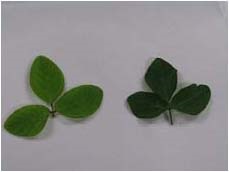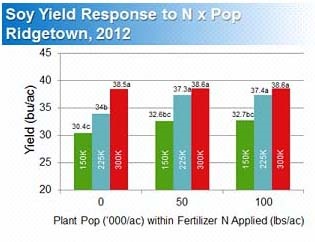Nitrogen application for high yielding soybeans
Learn the impact of applying nitrogen fertilizers to soybean yield.
Introduction
A high yielding soybean crop requires a tremendous amount of nitrogen (N) — up to 200 — 300 lbs/ac. Nitrogen fixation and residual soil nitrogen may not supply enough N for soybeans that yield over 70 bu/ac. Can "in-season" (early pod set stage) N application significantly increase soybean yield?
Nitrogen fertilizers have not traditionally been applied to soybeans. Up to 75% of the total nitrogen needs are supplied through biological N fixation through nodules on the roots. These nodules are formed in a symbiotic relationship with rhizobia bacteria. The plant provides the bacteria carbohydrates, minerals and a protected growing environment in exchange for N. However, perhaps biological N fixation cannot keep up to the high N demand of a bumper soybean crop. Photo 1 shows a nitrogen deficient soybean leaf, which is often found in many Ontario soybean fields.
There have been a number of studies conducted on supplemental N application. These studies have focused on different application timings, nitrogen products, and rates to determine if there is any advantage to applying additional N to soybeans.
Pre-plant N application
Applying N prior to seeding or as a starter fertilizer has not proven to be an effective way of improving net returns. Research from the United States and Ontario show that, while yield gains can be made, they are typically small (less than 2 bu/ac), inconsistant, and are not sufficient to increase profits. Yield gains are highly dependent on the year, where cooler and damper conditions have made N application more likely to result in yield gains. Under very poor growing conditions, low soil organic matter, low inorganic N, and conditions that are poor for nodulation, yield gains appear to be the most consistent. Under normal growing conditions there is usually no measurable yield gain.
Pre-plant N application when double cropping soybeans
Applying N when the crop is seeded very late in a double cropping situation may provide additional yield (Figure 2). The application of nitrogen in this scenario stimulates early plant development, which may help the soybean plant to make up for lost time earlier in the growing season. In 2012 there was up to 3.4 bu/ac extra yield when applying N to double cropped soybeans. However, an increased seeding rate with no nitrogen fertilizer yielded just as much as lower seeding rates with added nitrogen. Research into late planted soybeans best management practices is ongoing.
In season (early pod set) application
The greatest demand for nitrogen is when seeds are developing. At that time of year, soil N reserves are also depleting and N fixation is slowing. Perhaps this is the time of year to apply N to soybeans, especially when yield expectations are high. Trials conducted in Kansas in the late 90's showed a yield increase of 6.9 bu/ac with the application of 20 - 40 lbs/acre of N at the R3 stage. (Wesley et al,1998). However, yield gains were only realized in fields that had yields over 55 bu/ac and were irrigated. This spurred renewed interest in N application for soybeans and was followed up by a large number of studies. Unfortunately, subsequent research (Table 1) across the US Midwest showed inconsistent yield results in normal field situations.
| N application | Seed yield (bu/acre) | Seed protein (%) | Seed oil (%) | Seed N removal (lb/acre) |
|---|---|---|---|---|
| Control | 49.4 | 37.2 | 19.6 | 154 |
| Braodcast urea (July) | 50.3 | 37.0 | 19.6 | 155 |
| Knifed urea (July) | 50.3 | 37.4 | 19.6 | 157 |
| Broadcase poly-coated urea (July) | 51.0 | 37.4 | 19.5 | 159 |
| Knifed poly-coated urea (July) | 50.3 | 37.5 | 19.5 | 157 |
| Broadcast urea (August) | 50.3 | 37.6 | 19.5 | 158 |
| Significance | NS | Sign. | NS | Sign. |
July application in third week of July, R2 growth stage. August application in second week of August, R4–R5 growth stage. Knifed = six inch placement depth. Broadcast = over-the-canopy with no incorporation. All N applications at 75 lb N/acre. University of Minnesota.
In the Ontario SMART soybean trials, foliar nitrogen was applied during the reproductive stages that coincided with a fungicide application (early R3). 6 L/acre of foliar SRN (slow release nitrogen) was applied in a tank mix with a foliar fungicide. These trials also received 50 lbs/acre of actual N broadcast at seeding time in the form of ESN and ammonium sulphate. Yield gains were disappointingly small and ranged from 2–3 bu/ac. They were not economical.
Bottom line
Nitrogen fertilizer application to normal soybean fields has not provided consistent yield gains. Biological N fixation can provide the majority of required N supply for soybean unless there are soil restrictions for normal nodule activity. There is also evidence that very high yielding fields (over 70 bu/ac) may benefit from additional N, but trials actually yielding that high have been limited (F. Salvagiotti et al). Experience has shown little to no yield increase regardless of timing. Neither pre-plant or in-season N application is recommended under normal conditions.
Applying commercial nitrogen fertilizer is an expensive way to replace free nitrogen provided through biological N fixation. There are a few exceptions, where commercial nitrogen does make sense, such as a nodulation failure in a first time field. Fields with yield potential over 70 bu/ac still warrant more investigation. The best strategy for normal soybean production to make sure beans have adequate nitrogen is to inoculate seed before planting. Ontario trials have shown a yield gain of 1.2 bushels per acre when seeding soybeans treated with an inoculant.

